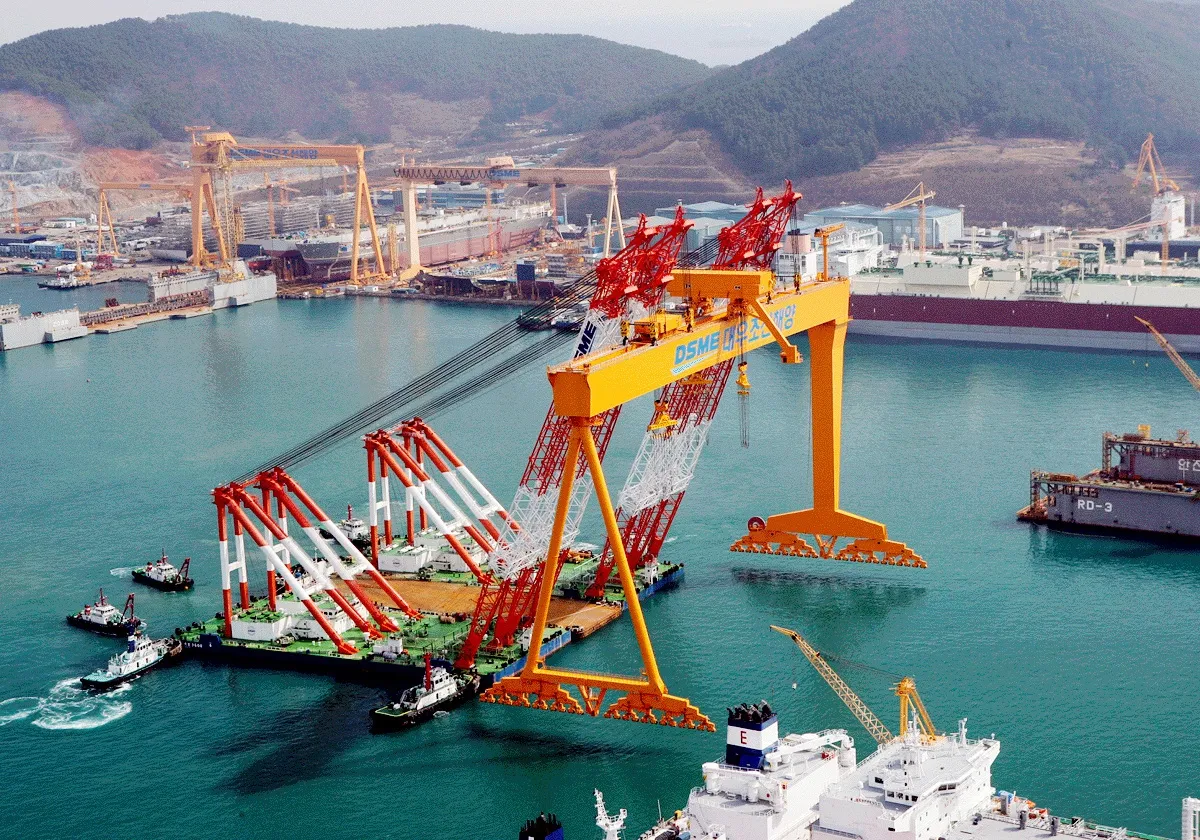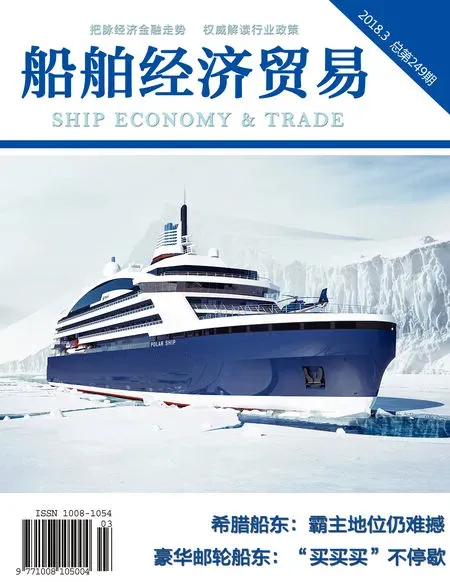Retrospect of Shipbuilding Competition among China, Japan and Korea in 2017
2018-04-02TanSongQiKai
Tan Song Qi Kai
On the wake of the extremely cold 2016, the global shipbuilding market finally bottomed out and new ship transactions rose sharply in 2017.Underlying the warming up shipbuilding market, newly received orders in three major shipbuilding countries -- China,Japan and Korea -- all grew year-onyear. New ship deals of Chinese ship manufacturers amounted to 32.39 million DWT and 9.19 CGT, a respective increase of 80.4% and 85.9%; new ship deals of Japanese ship manufacturers accounted for 7.58 million DWT and 1.99 million CGT, a respective increase of 39.5% and 14.1%; new ship deals of Japanese ship manufacturers made up 27.78 million DWT and 6.45 million CGT, a respective increase of 303% and 199%, hitting the largest increase. In the priority ship type sector, competition between Chinese and Korean ship manufacturers was the fiercest, orders secured by Korean ship manufacturers rebounded sharply due to substantial increase of domestic shipowners.

Overview of New Ship Order Transactions in 2017
In 2017, Chinese and Korean ship manufacturers both obtained orders of major ship types, competition in some priority ship type sector was fierce.
In the Capesize bulk carrier sector,orders on the global shipbuilding market hit 18.09 million DWT in 2017, a YOY increase of 41%. 26 VLOC orders transacted 325000 DWT, Korean Hyundai Heavy Industries secured 20 ships,Chinese ship manufacturers only obtained 6 ships, compared to 2016 when Chinese ship manufacturers obtained thirty 400000 DWT VLOC. Benefiting from massive orders of 180000 DWT and 208000 DWT bulk carriers, Chinese ship manufacturers accounted 53.8% of Capesize bulk carriers including ore carriers in 2017, compared with 35.9% for Korean ship manufacturers and 8% for Japanese ship manufacturers.
In Panamax bulk carrier sector,orders on the global shipbuilding market hit 10.78 million DWT in 2017, 41-fold of transactions in 2016 and this was the ship type with the largest deal growth in 2017. Chinese ship manufacturers took 68.3% of the market share, while Japan counterparts held 12.8%. it is worth noting that Philippine Changshi Cebu Shipyard relied on advantages of Japanese parent company and labor cost to obtain massive bulk carrier orders, Panamax bulk carrier orders received by Hyundai Viet Nam Shipyard and Southeast Asia Shipyard under Hyundai Heavy Industries accounted for 18.9%, while Korean ship manufacturers did not receive any order in the sector with unclear comparative advantages.
In the VLCC sector, orders on the global shipbuilding market hit 15.64 million DWT, a YOY increase of 245%.Korean ship manufacturers obtained 70% market share, Daewoo Shipbuilding Ocean obtained 13 ships, Hyundai Heavy Industries obtained 18 ships, and Samsung Heavy Industries obtained 4 ships. Orders received by Chinese ship manufacturers only made up 18%, Dalian Shipbuilding Industry Co Ltd obtained 7 ships, and Dalian COSCO Kawasaki Shipbuilding Engineering Co Ltd obtained 2 ships. Japanese ship manufacturers took up 11.9%. Aphra oil product tanker orders hit 3.44 million DWT in 2017,15-fold of deals in 2016, wrapped up by Chinese and Korean ship manufacturers.Dalian Shipbuilding Industry obtained 10 ships, Jiangsu New Era Shipbuilding Co Ltd obtained 8 ships, Guangzhou Shipbuilding International obtained 2 ships, and Korean Shipbuilding obtained the rest 10-ship orders.

In the large container ship sector,orders on the global shipbuilding market hit 5.3 million DWT, a YOY increase of 348%, and a number of 22000TEU ultralarge container vessels became flash point of the market. Mediterranean Shipping Co Ltd ordered 10 large container vessels,Samsung Heavy Industries obtained 6 ships, Daewoo Shipbuilding obtained 4 ships; French Dafayette’s order of 9 ultra-large container vessels was all obtained by ship manufacturer under CSSC. Furthermore, the transacted nine 14000TEU container vessels, Hyundai obtained 4 ships, and Japanese Maritime Association Co Ltd obtained 5 ships.In the transacted 12000TEU and above container vessel orders, orders taken by Chinese, Japanese and Korean ship manufacturers accounted for 34%, 13.2%and 52.9% respectively.
Ships Made in Home in “Bearish Market 2.0”
Double surplus capacity of shipping and shipbuilding market decided on the key note of the market game in 2016, depressed freight price and young ship structure restricted new ship order rhythm, and global shipbuilding industry entered material adjustment stage. The judgment that the global shipbuilding market is in “Bearish Market 2.0” remains unchanged, and in the circumstances of sliding orders at hand and underproduction of ship manufacturers, new orders received by ship manufacturers in 2017 had the characteristic of “Ships Made in Home”.

In 2017, orders taken by shipowners of China, Japan and Korean hit 26.01 million DWT, accounting for 35.7% of the global new ship orders. Orders taken by Chinese shipowners declined by 21.5%,orders taken by Japanese and Korean shipowners grew by 46% and 1444%respectively, the feature of “Ships Made in Home” was the most distinctive for Korean shipowners. Moreover,orders taken by Greek shipowners as main shipowners increased by 248%,accounting for 17.5% of the global new ship orders.
Orders from Chinese shipowners were the basis of increasing orders taken by Chines ship manufacturers, diversified shipowners were the guarantee for increasing orders received by Chinese ship manufacturers. Although orders placed by Chinese shipowners declined from 2016 and some were put by overseas shipyards, 39% of orders undertaken by Chinese ship manufacturers came from Chinese shipowners, aside from two central shipping enterprises, Chinese leasing institutions became an important source of orders taken by Chines ship manufacturers. Leasing institutions such as China Ship (Hong Kong) Shipping Leasing Co Ltd, ICBC Financial Leasing Co Ltd, CCB Financial Leasing Co Ltd,Minsheng Financial Leasing Co Ltd and Bank of China Financial Leasing Co Ltd ordered 5.298 million DWT, accounting for 40.1% of domestic shipowners’orders. Aside from this, Chinese ship manufacturers obtained orders from 37 shipowner countries, and they were the countries with the most extensive shipowner sources, reflecting strong attraction of Chinese ship manufacturers.
E i t h e r J a p a n e s e p l a n n e d shipbuilding implemented in early stage or influence of the Nippon Consortium System on the shipbuilding industry caused a considerable part of orders of Japanese ship manufacturers came from domestic shipowners. 51% of orders obtained by Japanese ship manufacturers in 2017 came from domestic shipowners,followed by Chinese shipowners.
Despite similarity of Korean shipping and shipbuilding industries with Japan, scale and strength of Korean shipowners have big differences with Japan. Orders taken by Korean shipowners stood at 590000 DWT in 2016 and the figure grew to 9.11 million DWT in 2017,the highest in recent four years and 90.3%of orders taken by Korean shipowners were obtained by domestic shipowners;in new orders obtained by Korean ship manufacturers, Korean shipowners made up 29.6%, and this paved the way for Korean ship manufacturers realizing the largest growth of new ship orders among the three majors in 2017.
Although affected by the sluggish shipbuilding market and financial crisis,Greek shipowners, the largest size in the world, remain backbone and wind vane of the shipping market. In 13.4 million DWT orders of Greek shipowners in 2017, Korean ship manufactures obtained 58% of orders, they were all oil and gas ship orders, including 18 VLCC, largely contributing to yearly VLCC orders obtained by Korean ship manufacturers;in shipowner sources of new orders obtained by Korean ship manufactures,Greek shipowners made up 28.1%, second only to Korean shipowners. Chinese ship manufacturers obtained 35% of orders,they were all bulk carrier and container vessel orders, a big share in Panamax bulk carrier order obtained by Chinese ship manufacturers in the whole year; in shipowner sources of new orders obtained by Chinese ship manufacturers, Greek shipowners made up 14.1%, ranking second.
杂志排行
船舶经济贸易的其它文章
- Shandong to Build a Port& Shipping Power
- Shorten Piping Cleaning Cycle to Speed up Shipbuilding
- Chinese Ship Manufacturers Pick up Roro Pax Market
- Fujian Shipyards’ Professional Teams Contribute to Better Competitiveness
- New Technology Assists in Completion of Global First Smart Merchant Ship
- 美军舰艇如何海外维护及改装?
